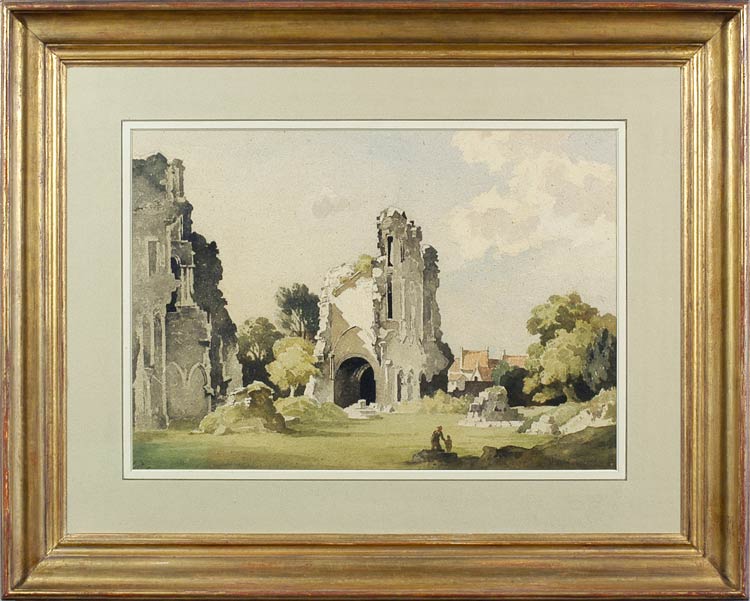A finished watercolour study of an unidentified site, almost certainly in Britain, with the ruins of a mediaeval castle or abbey amongst trees, with red-tiled houses beyond. Nicholls ranged so widely in his painting tours through Europe and the British Isles that it is all but impossible to track the buildings he visited. In default of a catalogue raisonné, one resource is the very partial list compiled by Andrew Broadhurst at familytreemaker.genealogy.com, where his page on Bertram Nicholls brings together some of the paper and online records of the works. Even a quick glance at this reveals the difficulty of identifying Nicholls’s subjects; he painted, amongst many other sites, Windsor Castle, Goodrich Castle, Dunster Castle, Castle Bolton, Stokesay Castle, Abergavenny Castle, Porchester Castle, ‘castle ruins’ and ‘a sunlit ruin’. None of these named locations seems to be the subject here; nor does it seem to be any of the more notable English abbeys. Wherever it may be, it has been accorded Nicholls’s full and characteristically careful treatment; the composition and lighting underline the drama of the ruins, which are contrasted with the natural setting, the tiny foreground figures, and the group of domestic houses beyond. There may well be an allegorical undertow to this particular arrangement, since the height of the ruins seems to be emphasized in relation to the rest of the landscape, as though to point the fact of their imminent engulfing by Nature, the constant encroachment of more transient domestic buildings, and the place of man (though even more ephemeral) in the foreground of the world.
Biographical details
Bertram Nicholls (1883-1974) was born at Didsbury, son of a Manchester businessman. He trained with Reginald Barber, a local portrait painter, and then for three years at the Slade, ‘but two of those years, he maintains, were wasted.’ In 1904 he studied Velasquez in Madrid; on his return he worked with Frederick Jackson, one of the Staithes Group of artists [see John William Howey], with whom he learnt landscape painting en plein air. In 1911 he met the New York artist Frank Mura and later settled in Sussex, very near Mura, whose work was a formative influence on his own art; two further important influences were Reynolds and Richard Wilson.
Nicholls exhibited at the Royal Academy from 1912; from 1923-34 he was president of the Manchester Academy of Fine Arts, and in 1931 was elected president of the Royal Society of British Artists. His first one-man show (a sell-out) was held at Barbizon House in 1924; he exhibited there in 1926, 1928 and 1932; in 1933 he had his first exhibition of watercolours at the Fine Art Society.
Works in public collections include San Giovanni Nepomuceno (Maidstone Museum & Art Gallery); Rochester Castle (Bradford Museums & Galleries); Quay in Italy (Southend Museum Service); Chepstow Castle and The Bridge (both Worthing Museum and Art Gallery); Riverside town (Brighton & Hove Museums & Art Galleries); Lancing Chapel (Towner Art Gallery); and others in Aberdeen Art Gallery and Museums; Adelaide, Art Gallery of South Australia; New Zealand, Auckland Art Gallery; Birmingham Museum and Art Gallery; Bristol City Museum & Art Gallery; National Gallery of Ireland; Liverpool, Walker Art Gallery; London, British Museum, Guildhall Art Gallery and Tate; Manchester City Art Gallery; Montreal Museum of Fine Arts; National Gallery of Canada; Preston, Harris Museum and Art Gallery.
See the RSBA publication of his work – Bertram Nicholls (1883- ), Frank Rutter, 1935, ed. of 750 – which quotes Nicholls extensively from articles in The Artist, VI, nos 1-6, Sept.-Dec. 1933 & Jan.-Feb. 1934. See also Painting in Oils by Bertram Nicholls, The Studio Publications, 1945.


